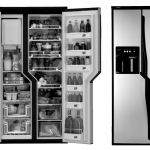Arrrrrriigghtt, our fridge is fixed..maybe! It’s 6am and I’m waiting it out. The photo, by the way is from the Dometic manual for our glorious NDA 1402 refrigerator. Wait: did I say maybe? Yes, Yes I did!
The folks at Independence RV in Winter Garden got the fridge to start on Thursday. All the lights and settings that are supposed to be there for a working fridge are there. The question is now “will it cool?”
I said the fridge came alive Thursday, so why don’t I know yet? Well, first of all, we went back in to the dealership on Friday because the fridge was giving off a burning smell when it was switched to run on propane. No need to panic though, that was just burn off from the flume as it was breaking in.
Ok, that was Friday, so why don’t we know yet??? Well, RV fridges cool using a completely different technology than home refirgerators. A home based fridge uses a compressor to compress a gas (affectionally known as HFC-134a) creating heat that is then taken to a condenser to expand. When it expands, the gas cools and voila: modern refrigeration!
RV refrigerators, however, do not use a compressor and have no moving parts. Instead of compressing HFC-134a, a RV fridge warms an ammonia-water mixture to its boiling point before routing it to a separator to remove the water from the mixture. The liquid ammonia is then sent to a condenser which cools the ammonia back to a liquid. The liquid is then mixed with hydrogen at an evaporator to cool the yummy yummies you plan on eating. The ammonia hydrogen mixture then moves to absorber where it mixes with water to seperate the hydrogen (thereby sending it to back the evaporator.) Finally, the water-ammonia mixture goes to the start point and the process starts all over again.
Advantages:
- No moving parts – something to value when your whole house is barreling down the highway at 60 miles an hour and vibrating like mad.
- An electric heater or a propane flame can be used to boil the ammonia-water mixture. Nerds call this elimination of a single point of failure by multiple redundant systems (this makes nerds happy).
Disadvantage:
- This is not exactly a fast process. An RV fridge can take 1-2 days depending on ambient temperature- which in Florida in July means the furnace of death we are living in!
As of last night the temperatures in the refrigerator and freezer were 33F and 32F respectively (this is an improvement over the 48 and 38 the day before and 58/48 the previous day) Today is the day! I’m not opening the fridge just yet…not…just…yet….DANG IT I WANT TO OPEN THE FRIDGE!!! But, i’m waiting (waiting sucks..arrghhhhhhhhhhh). I’m waiting.
By the way, we also have a new ice maker in the fridge and it will not make ice until the freezer gets below 32. Come on baby! Give hit me with some ice!
I’ll report later when we see what happens. Come on big G: cool!










































Leave A Reply